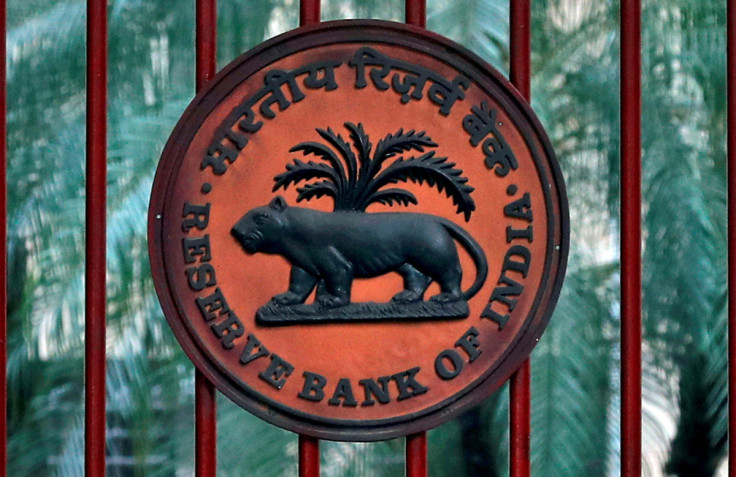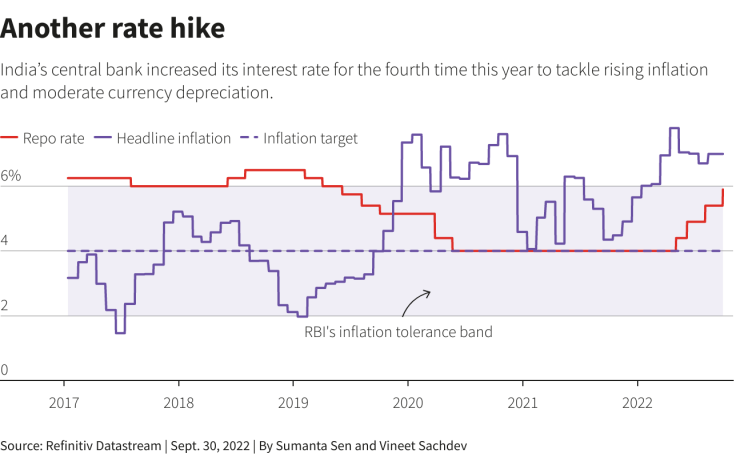India's Cenbank Hikes Rate By 50 Bps, Warns Of Broadening Price Pressures

The Reserve Bank of India raised its benchmark repo rate by 50 basis points on Friday, the fourth straight increase, as policymakers extended their battle to tame stubbornly high inflation and analysts said further tightening is on the cards.
The monetary policy committee (MPC), comprising of three members from the RBI and three external members, raised the key lending rate or the repo rate to 5.90% with five out of the six voting in favour of the hike.
The RBI has now raised rates by a total 190 basis points since its first unscheduled mid-meeting hike in May but inflation continues to remain stubbornly high - a phenomenon that is affecting much of the global economy.
GRAPHIC: Another rate hike

"The inflation trajectory remains clouded with uncertainties arising from continuing geopolitical tensions and nervous global financial market sentiments," Governor Shaktikanta Das said in his address accompanying the MPC's decision.
"In this backdrop, MPC was of the view that persistence of high inflation, necessitates further calibrated withdrawal of monetary accommodation to restrain broadening of price pressures, anchor inflation expectations and contain the second round effects," he said.
The MPC also was of the view the current policy rate, adjusted for inflation, was still below 2019 levels.
Most economists expect further tightening although they differ on the quantum of hikes needed in the current cycle.
"At this point, we still think that the RBI would not go too restrictive and terminal rate could hover near the estimated real rates, implying not more than 100 bps hikes ahead, including today's decision," said Madhavi Arora, lead economist at Emkay Global Financial Services.
FED ANGST
The U.S. Federal Reserve's relentless and aggressive interest rate hikes over recent months to curb inflation have battered the rupee, and most other emerging and developed market currencies.
"Clearly, the fast-evolving world order and consistent repricing of Fed's out-sized hikes are strong-arming the emerging markets," Arora said.
Policymakers around the world are grappling with a sweeping shift away from their respective currencies and into the safe-haven dollar, raising worries of capital outflows and further damage to their economies.
Economists say the RBI too would need to focus on ensuring the interest rate differential is not too low.
GRAPHIC: EM policy rate moves

The standing deposit facility rate and the marginal standing facility rate were also increased by the same quantum to 5.65% and 6.15%, respectively.
The MPC lowered its GDP growth projection for financial year 2023 to 7% from 7.2% earlier, while its retail inflation forecast was held steady at 6.7%.
India's annual retail inflation rate accelerated to 7% in August, driven by a surge in food prices, and has stayed above the RBI's mandated 2-6% target band for eight consecutive months.
The benchmark 10-year bond yield eased marginally after the RBI's decision to 7.3636% at 0615 GMT while the partially convertible rupee weakened briefly before bouncing to 81.57 per dollar versus 81.86 on Thursday.
The NSE Nifty 50 index recovered ground and was trading up 0.90% at 16,969.85, and the S&P BSE Sensex rose 0.93% to 56,930.07.
© Copyright Thomson Reuters {{Year}}. All rights reserved.





















